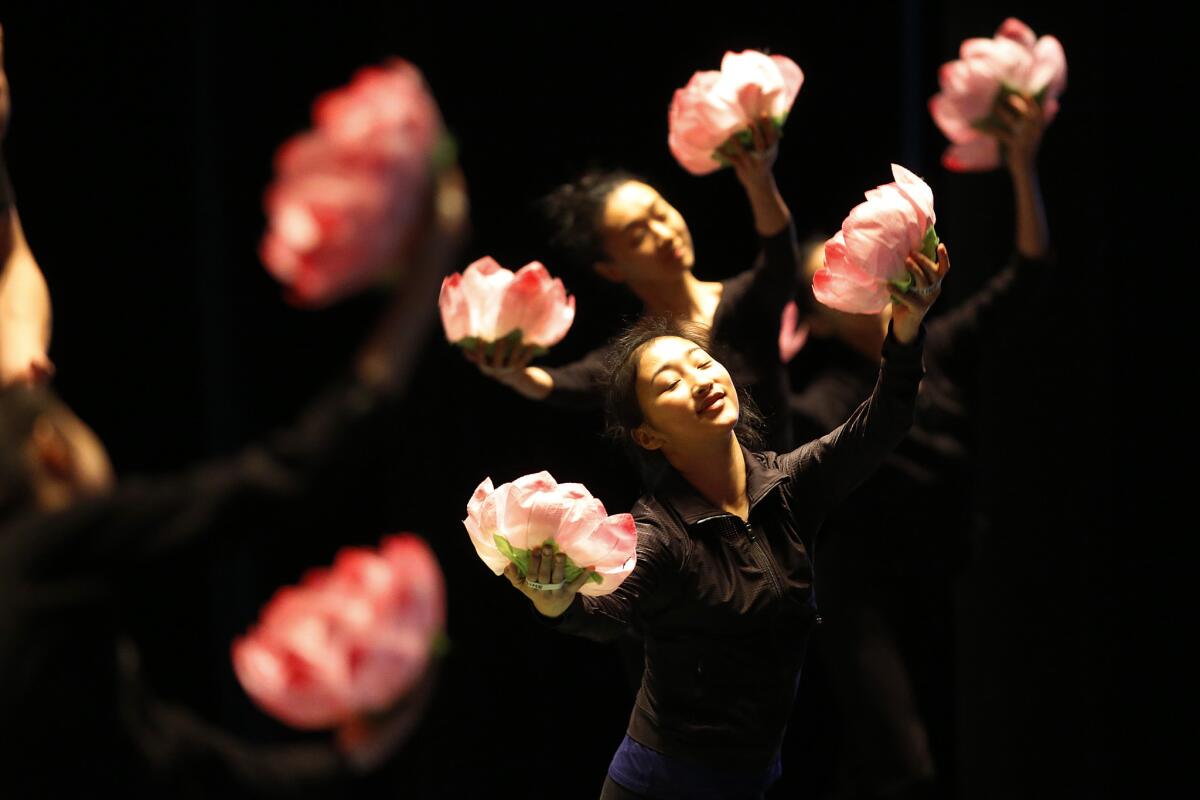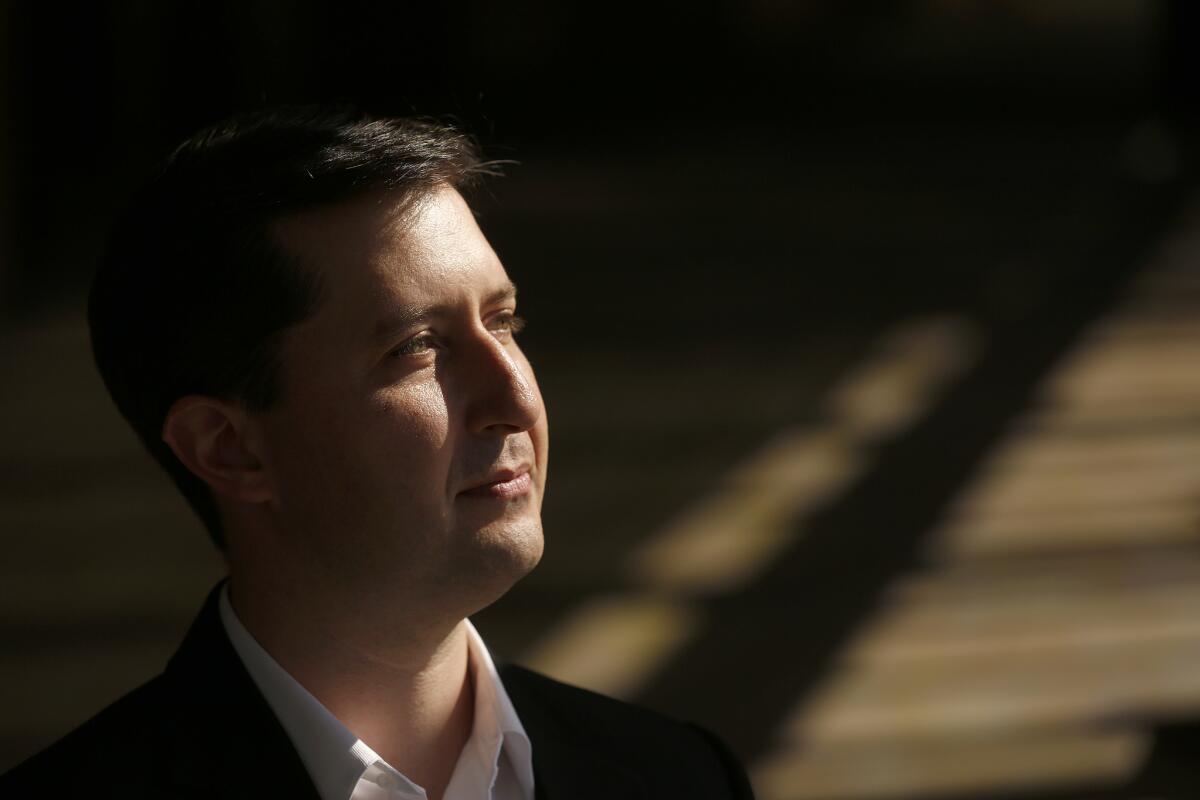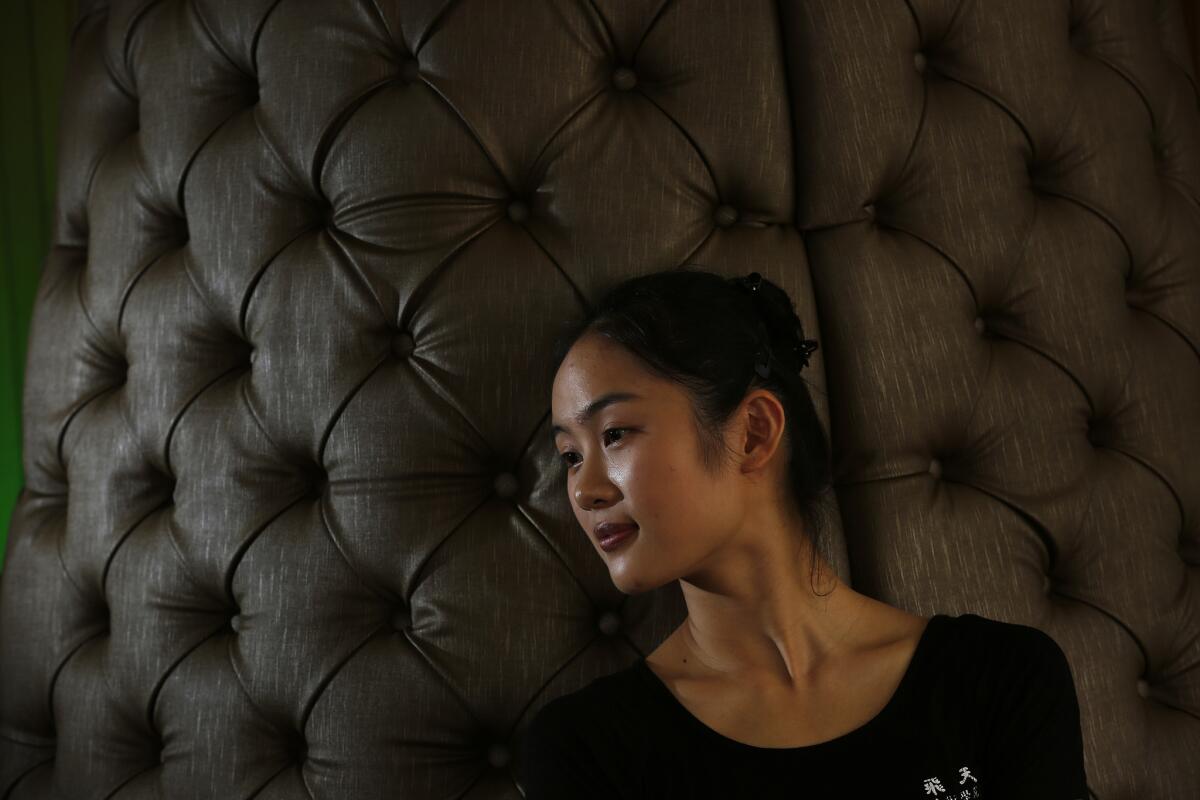Falun Gong, banned in China, finds a loud protest voice in the U.S. through Shen Yun dance troupe

Shen Yun, founded by practitioners of Falun Gong, performs in more than 100 cities worldwide, including Claremont this weekend.
- Share via
The cavernous Long Beach Terrace Theater echoes with classical Chinese music as more than a dozen dancers expertly manipulate colorful fans that sweep like wind and snap like fire. In precise formation they coalesce into a river of dance inspired by Chinese history, legend, myth and literature.
The performers are serious and determined. The only direction they receive comes from a calm woman dressed in black, standing near the theater’s center. She speaks in Mandarin — her words few, her manner direct.
It’s rehearsal time for Shen Yun Performing Arts, a touring dance troupe founded in New York by practitioners of Falun Gong, the spiritual practice banned by the Chinese Communist Party in 1999.
See more of Entertainment’s top stories on Facebook >>
The party calls it a cult; Falun Gong says the Chinese government is trying to eradicate thousands of years of culture and tradition and that its repression of Shen Yun shows an intolerance of freedom of expression and religion. Indisputably, the dance company — marking its 10th anniversary — has become a cultural phenomenon.
A single company has grown to four troupes that perform each year in more than 100 cities in 30-plus countries. In Southern California, Shen Yun stages more than 30 shows a year. The group will perform in Claremont on Saturday and Sunday, followed by stops in Costa Mesa, Northridge, Bakersfield and the Microsoft Theater in downtown L.A., ending April 29-30 in Santa Barbara.
“The show is 5,000 years of culture in one night,” said Felipe Sena, a creative director for a fragrance company who caught a performance at Lincoln Center in New York in March. “The colors are amazing, the message is very lyrical and clear.”
Many go to the performances unaware of the political undertones to the shows, even though one or two dances deal directly with Falun Gong’s clash with the Chinese Communist Party.
Nonetheless, it’s safe to say that the bright costumes and spinning dancers are meant to convey a message. “The Falun Gong has a very well organized, managed and elaborate program of public relations, and Shen Yun is part of that,” said James Tong, a UCLA professor, expert in Chinese politics and author of a book about the Communist Party and Falun Gong. When audiences see Shen Yun, “people want to know more about the Falun Gong.”
Falun Gong was founded by spiritual leader Li Hongzhi in 1992. By the late 1990s, it claimed an estimated 70 million followers inside China. It emphasizes the traditions of Buddhism, meditation and tai chi, and at its inception it enjoyed a close relationship with the Chinese Communist Party.
But when the government began to crack down on groups promoting qigong, an ancient Chinese practice of holistic medicine that espouses breathing techniques to promote good health, the Falun Gong was among those targeted.
The Falun Gong has a very well organized, managed and elaborate program of public relations, and Shen Yun is part of that.
— James Tong, UCLA professor
The group responded by staging brazen protests. At one point 20,000 followers surrounded party headquarters in Beijing. After that, the government deemed the practice of Falun Gong illegal. Practitioners have accused the government of persecution, repression and brutalization. Shen Yun represents an artistic response in this struggle.
The dance troupe is just one part of a cultural program promoted by Falun Gong that includes international music, martial arts, Chinese cooking and Chinese fashion competitions as well as special summer and winter camps for children, Tong said. He’s uncertain if these programs are meant to be political tools, but he believes they have that effect because they cultivate positive relationships with local communities and governments.
The Falun Gong organization is notoriously reclusive and declined a request for an interview, but the group’s mission is stated on the Shen Yun website: “For 5,000 years divine culture flourished in the land of China. Humanity’s treasure was nearly lost, but through breathtaking music and dance, Shen Yun is bringing back this glorious culture.”
Inside China, “traditional Chinese spiritual practice has been very demonized,” said local Shen Yun promoter Wen Chen, who left China after college. “We were taught that Buddhism was stupid, so a lot of Chinese students came to the U.S. and realized they were brainwashed. In the United States they saw something authentic. They were able to read freely and speak freely and they started to appreciate traditional Chinese practices and spiritual guidance.”
Chen acknowledged, however, that most of Shen Yun’s audience members aren’t arriving for spiritual guidance. They simply delight in the dancers, singers and musicians as well as the myths and legends that are told through vigorously acrobatic dance routines. The elaborate costumes and props don’t hurt either, nor do the digital effects projected on a wall behind the stage.
That, however, doesn’t prevent the core message of “truthfulness, compassion and tolerance” from infecting the audience, Chen said.

Shen Yun emcee Jared Madsen
The website for the Chinese Embassy in the United States has a different point of view: “‘Shen Yun’ is not a cultural performance at all but a political tool of ‘Falun Gong’ to preach cult messages, spread anti-China propaganda, increase its own influence and raise fund. It blasphemizes and distorts the Chinese culture, and deceives, fools and poisons the audience.”
Falun Gong has been regarded by some as more personality cult than religion because Li is known as “Master Li,” and his instructions and sayings are recorded as sacred scripture. Although it has no management body, Falun Gong has an estimated 80 million to 100 million followers worldwide.
Shen Yun emcee Jared Madsen discovered Falun Gong while attending high school and college in China in the 1990s, before it was banned. When he heard about Shen Yun in 2006, he immediately applied and has been touring with the show ever since. His role is to come onstage between dances with a fellow emcee and tell the story or legend about to be danced. Madsen speaks in English, while his counterpart speaks in Mandarin.
In Madsen’s opinion, Shen Yun has not suffered from its association with Falun Gong, and he doesn’t think audience members walk away feeling the show was about politics. “The only resistance we’ve seen has been from the Chinese Communist Party Consulate,” he said. “In the beginning they would call the theaters and tell them not to let Shen Yun perform.”
That tactic was never effective in America, Madsen said.
Today the dance troupe can barely book enough shows to satisfy public demand in some locations. One year, Chen said, the Southern California wait list for tickets was hundreds of people long. That year Chen sacrificed her personal tickets for the cause.

Shen Yun principal dancer Angelia Wang.
Such devotion is not rare among those who work with Shen Yun, whose financial success is partly because of volunteers. Chen, for example, works as a biologist for Caltech but dedicates her nights and weekends for six months out of the year to book Shen Yun shows throughout Southern California. When she started nearly 10 years ago, the volunteer base was nearly 100 strong, though she said those ranks have dwindled significantly now that Shen Yun can sustain itself largely on word of mouth.
Dancers, singers and musicians do get paid; according to the nonprofit organization’s most recent federal filing, about $4.5 million of its $7.1 million in expenses for 2014 went toward wages. (Compensation to all officers and board members added up to less than $100,000.) The group reported revenue of $18.1 million in 2014, and net assets totaled more than $38 million.
The group said all proceeds from the performance go back to Shen Yun to pay the show’s artists and to support the operation of Fei Tian Academy of the Arts in New York, which acts as a feeder school to Shen Yun. Falun Gong does not receive income from the shows, a Shen Yun representative said.
For some of the performers, Shen Yun is more than a job. It’s a new way of life.
“I left home when I was 13,” said Shen Yun principal dancer Angelia Wang, who is 22 and has been with the company since 2007, when she enrolled in Fei Tian Academy. “I didn’t see my parents for seven years. I would get persecuted if I came back. I had no idea when I left, I was really clueless.”
Twitter: @jessicagelt
ALSO
Bob Dylan returns to pop standards on new album ‘Fallen Angels’
Bruce Springsteen cancels North Carolina concert over state’s anti-LGBT bill
N.W.A among Rock and Roll Hall of Fame inductees prepping for induction
More to Read
The biggest entertainment stories
Get our big stories about Hollywood, film, television, music, arts, culture and more right in your inbox as soon as they publish.
You may occasionally receive promotional content from the Los Angeles Times.











